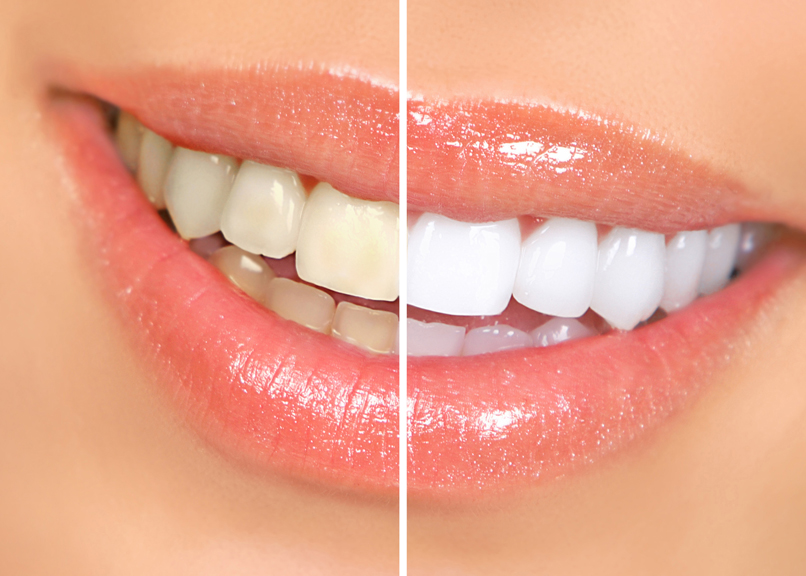Cosmetic
VENEERS
Veneers are thin, custom-made shells crafted of tooth-colored materials designed to cover the front side of teeth. They are an option for correcting stained, chipped, decayed or crooked teeth. Veneers are made by a dental technician, usually in a dental lab, working from a model provided by your dentist. Placing veneers is usually an irreversible process, because it’s necessary to remove a small amount of enamel from your tooth to accommodate the shell. Your dentist may recommend that you avoid some foods and beverages that may stain or discolor your veneers such as coffee, tea or red wine. Sometimes a veneer might chip or fracture. But for many people the results are more than worth it.
If you have any questions about veneers ask your dentist.
PORCELAIN CROWNS
If you want a smile that’s your crowning glory, you may need a crown to cover a tooth to help restore it to its normal shape and size. A crown can make your tooth stronger and improve its appearance.
A crown can help strengthen a tooth with a large filling when there isn’t enough tooth remaining to hold the filling. Crowns can also be used to attach bridges, protect a weak tooth from breaking or restore one that’s already broken. A crown is a good way to cover teeth that are discolored or badly shaped. It’s also used to cover a dental implant.
If your dentist recommends a crown, it is probably to correct one of these conditions. Your dentist’s primary concern, like yours, is helping you keep your teeth healthy and your smile bright.
TOOTH WHITENING
Everybody loves a bright white smile, and there are a variety of products and procedures available to help you improve the look of yours. Many people are satisfied with the sparkle they get from daily oral hygiene and regular cleanings at your dentist’s office, but if you decide you would like to go beyond this to make your smile look brighter, you should investigate all of your whitening options.
Start by speaking with your dentist. He or she can tell you whether whitening procedures would be effective for you. Whiteners may not correct all types of discoloration. For example, yellow-ish hued teeth will probably bleach well, brownish-colored teeth may bleach less well, and grayish-hued teeth may not bleach well at all. If you have had bonding or tooth-colored fillings placed in your front teeth the whitener will not affect the color of these materials, and they will stand out in your newly whitened smile. You may want to investigate other options, like porcelain veneers or dental bonding.

If you are a candidate for whitening there are several ways to whiten your smile:
- In-office bleaching. This procedure is called chairside bleaching and usually requires only one office visit. The dentist will apply either a protective gel to your gums or a rubber shield to protect the oral soft tissues. A bleaching agent is then applied to the teeth, and a special light may be used. Lasers have been used during tooth whitening procedures to enhance the action of the whitening agent.
- At-home bleaching. Peroxide-containing whiteners actually bleach the tooth enamel. They typically come in a gel and are placed in a mouthguard. Usage regimens vary. There are potential side effects, such as increased sensitivity or gum irritation. Speak with your dentist if you have any concerns.
- Whitening toothpastes. All toothpastes help remove surface stain through the action of mild abrasives. “Whitening” toothpastes in the ADA Seal of Acceptance program have special chemical or polishing agents that provide additional stain removal effectiveness. Unlike bleaches, these ADA Accepted products do not change the color of teeth because they can only remove stains on the surface.
Remember when selecting a whitener or any dental product, be sure to look for the ADA Seal of Acceptance—your assurance that they have met ADA standards of safety and effectiveness.

Call 860-482-8588 to schedule your appointment. Our office staff will be happy to assist you!

BONDING
Dental bonding is a procedure in which a tooth-colored resin material (a durable plastic material) is applied and hardened with a special light, which ultimately “bonds” the material to the tooth to restore or improve a person’s smile. Dental bonding is an option that can be considered:
- To repair decayed teeth (composite resins are used to fill cavities)
- To repair chipped or cracked teeth
- To improve the appearance of discolored teeth
- To close spaces between teeth
- To make teeth look longer
- To change the shape of teeth
- As a cosmetic alternative to amalgam fillings
- To protect a portion of the tooth’s root that has been exposed and/or eroded when gums recede
Procedure:
Preparation: Frequently little advanced preparation is needed for dental bonding. Anesthesia often is not necessary unless the bonding is being used to fill a decayed tooth or a sensitive root. Your dentist will use a shade guide to select a composite resin color that will closely match the color of your tooth.
Restoration: Next, the surface of the tooth will be roughened and a conditioning liquid applied. These procedures help the bonding material adhere to the tooth. The tooth-colored, putty-like resin is then applied, molded, and smoothed to the desire shape and contour. A curing light is then used to harden the material. After the material is hardened, your dentist will further trim, shape and polish it to match the sheen of the rest of the tooth surface.
Advantages and Disadvantages of Dental Bonding:
Advantages: Dental bonding is among the easiest and least expensive of cosmetic dental procedures. Unlike veneers and crowns, which are customized tooth coverings that must be manufactured in a lab, bonding usually can be done in one visit unless several teeth are involved. Another advantage, compared with veneers and crowns, is that the least amount of tooth enamel is removed. Also, compared to veneers and crowns, dental bonding is easily repairable. Finally, unless dental bonding is being performed to fill a cavity, anesthesia is usually not needed.
Disadvantages: Although the material used in dental bonding is somewhat stain resistant, it does not resist stain as well as veneers and crowns. Another disadvantage is that the bonding materials do not last as long nor are as strong as other restorative procedures, such as crowns, veneers, or fillings. Additionally, bonding materials can chip and break off a tooth.
Because of some of the limitations of dental bonding, some denitist view it as best suited for a small cosmetic change, for temporary correction of a cosmetic defect, and for correction of teeth inareas of very low bite pressure (for example, front teeth). Consult with your dentist about the best cosmetic approach for your particular problem.
PORCELAIN FIXED BRIDGES
If you’re missing one or more teeth, you may notice a difference in chewing and speaking. Bridges can help restore your smile.
Sometimes called a fixed partial denture, a bridge replaces missing teeth with artificial teeth and literally “bridges” the gap where one or more teeth used to be. Bridges can be made from gold, alloys, porcelain or a combination of these materials and are attached to surrounding teeth for support. Unlike a removable bridge, which you can take out and clean, a fixed bridge can only be removed by a dentist.
COMPOSITE FILLINGS
Composite resins, or tooth-colored fillings, provide good durability and resistance to fracture in small- to mid-size fillings that need to withstand moderate pressure from the constant stress of chewing. They can be used on either front or back teeth. They are a good choice for people who prefer that their fillings look more natural.
Composites cost more than amalgam and occasionally are not covered by some insurance plans. Also, no dental filling lasts forever. Some studies show that composite fillings can be less durable and need to be replaced more often than amalgam fillings.
It generally takes longer to place a composite filling than it does for a metal filling. That’s because composite fillings require the tooth be kept clean and dry while the cavity is being filled. Tooth-colored fillings are now used more often than amalgam or gold fillings, probably due to cosmetics. In a society focused on a white, bright smile, people tend to want fillings that blend with the natural color of their teeth.
Ultimately, the best dental filling is no dental filling. Prevention is the best medicine. You can dramatically decrease your risk of cavities and other dental diseases simply by:
- brushing your teeth twice a day with fluoride toothpaste
- flossing daily
- eating a balanced diet
- visiting the dentist regularly.